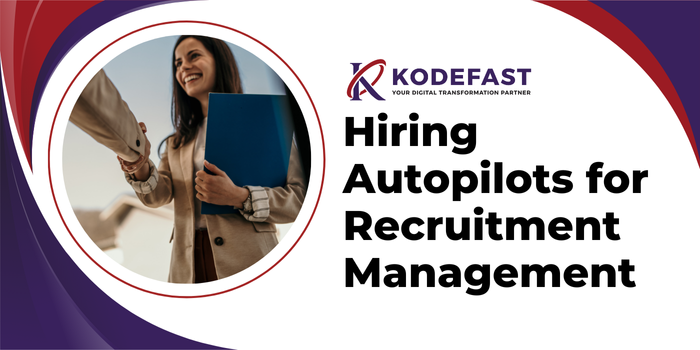
Hiring Autopilots: A Technology-Driven Global Approach to Hiring and Management
November 14, 2024Hiring trends are changing at the speed of lightning globally due to fast-paced changes taking place across manufacturing and service sectors. Recruitment and human resource management are truly global in many companies that have projects spread across geographic locations.
Companies also rely upon the global talent pool for certain critical skills that can’t be groomed or nurtured locally. AI-powered human resource management platforms are acting as “hiring autopilots,” assisting HR managers in recruitment drives, people and payroll management at a scale.
Definition of Hiring Autopilots
The concept of autopilots in HR differs from that of autonomous vehicles. Hiring autopilots are SaaS platforms that allow HR managers to automate a variety of critical, mundane, time-consuming and complex activities and processes to focus on people-centric upskilling, training and development activities.
The factors that contribute to borderless hiring and people management practices are numerous.
Consider these trends on the production side.
Global pressure on climate challenges, the fuel crisis and the rising cost of fuel are primarily driving the increasing popularity of electronic vehicles over traditional ones. Government policies aimed at providing more incentives to manufacturing companies are also leading to the establishment of semiconductor chip companies in the US. Recently, the American Congress approved $53 billion in funding to boost this sector. Despite the government ‘s aid, HR managers finding it tough to pool human capital locally.
The aging population in the US and European workforce, as well as massive shifts in job roles thanks to the faster pace of automation, are redefining the way organizations have functioned for ages. Several coding jobs, coordination and office roles have either disappeared, restructured, or reallocated in different ways. For example, IT companies are expecting program developers to conduct regression tests to ratify their functions. Again, scrum master jobs meant for coordinating and reporting the functions of various departments have disappeared thanks to AI-powered automation in organizations.
How is global job market volatility impacting hiring strategies?
Global job market trends have been trading increasingly negatively since 2018, even before the onset of COVID-19. The job market recovery is feeble and tumultuous. Both layoffs and high employee attrition caused an acute shortage of highly skilled workers at the local level. Mass employee resignations are not without economic costs.
According to McKinsey's analysis of the value of talent, companies spend $52,000 annually on recruiting, training and onboarding, which goes above and beyond the salary of each frontline employee. Departure of employees impacts productivity losses. Manufacturing companies are experiencing 17.8 percent annual attrition, equal to 20,000 workers—70 percent of them at the front line. This has a financial impact on companies' revenue loss of $12.6 billion each year. Companies could save significantly by reducing attrition by 6.2 percentage points would result in an annual savings of $226 million, as they could save time and money by filling vacancies from 20 days to 10 days.
Why are companies going global with talent pooling?
Companies could not get a rich and experienced talent pool to fill certain entry-level and high-end jobs for various reasons. In the US, community colleges are unable to prepare freshmen for manufacturing jobs due to a shift in employee demographics, resulting in either a complete lack of training or a shortage of trainers. Despite significant federal funding allocation for training and internships, it is time-consuming to prepare local talents. Companies can’t postpone project deliveries as they race against time to meet deadlines.
How do hiring autopilots support remote hiring and effective people management?
The HR heads are under tremendous pressure to recruit a qualified and experienced talent pool to manage projects. They often look for talent who must possess technical and people management skills. Hiring Autopilots could help you visualize the team's needs and they are quick and efficient.
- Streamlines the recruitment process
Autopilots are quick at sourcing and screening many applications. The embedded Applicant Tracking System (ATS) scans resumes based on keywords and pre-defined criteria automatically and shortlists candidates quickly and more efficiently.
- Effective and immediate communication
HR managers can automate a good number of hiring activities, such as dispatching timely communication to the short-listed candidates and scheduling interviews automatically, by cross-verifying the candidate's availability. They can prepare personalized invitations and manage candidate scheduling conflicts effectively.
- Preliminary Screening, Assessment and Training
Autopilot tools administer pre-defined questions and can assess pre-employment assessments or skills tests that candidates can take online, automatically scoring them based on pre-set parameters. HR managers can automate several practices, including employee onboarding, dispatching welcome emails, setting up new employee accounts and scheduling training materials.
- AI-Powered Human Resource Management
Hiring autopilots helps HR managers with efficient payroll management, employee tax filing, bank account opening and insurance management. This would standardize human resource management practices and relieve HR managers from manual document and data management activities. HR departments can spare ample time thanks to AI-powered human resource management for employee upskilling and training. Many studies on consumer goods manufacturers showed that about 90 percent of employees who opted into the company’s career development program are still with the company today.
- End-to-end recruitment management
HR departments spend several hours gathering job requirements from various teams, preparing job descriptions, and then notifying or sharing these across job boards or social platforms. HR managers can spare ample time by automating the above-mentioned tasks now. AI-powered no-code platforms can now generate job descriptions, and customize them and save them as templates for multiple stakeholders to share. Hiring autopilot is helpful for preliminary resume screening, scheduling interviews and communicating with job seekers.
- Utilizing AI capabilities to streamline payroll and tax management
AI-powered No-Code platforms allow HR managers to build multiple web-based or mobile applications that streamline employee attendance, employee performance tracking, payroll calculation & processing and IT return submission in no time. They can accomplish these many tasks either from scratch or by uploading an Excel sheet with data.
- Intuitive Dashboard Analytics
HR managers can customize their analytical dashboard to draw insights to track recruitment pace, employee performance, projects in progress, payrolls, inventories, spending or expense management and more. Autopilot provides glimpses into the HR department’s functions and performance, helping HR managers assess challenges, design new hiring strategies and find innovative solutions to drive excellence.
Important Takeaways
Hiring Autopilot is here to stay with the HR departments and is poised to bring more innovation. The AI-powered human resource management platforms automate the entire recruitment, payroll and taxation process. They are user-friendly and cost-effective. Hiring autopilot is making headways for the optimum utilization of resources for hiring, recruitment and training.

